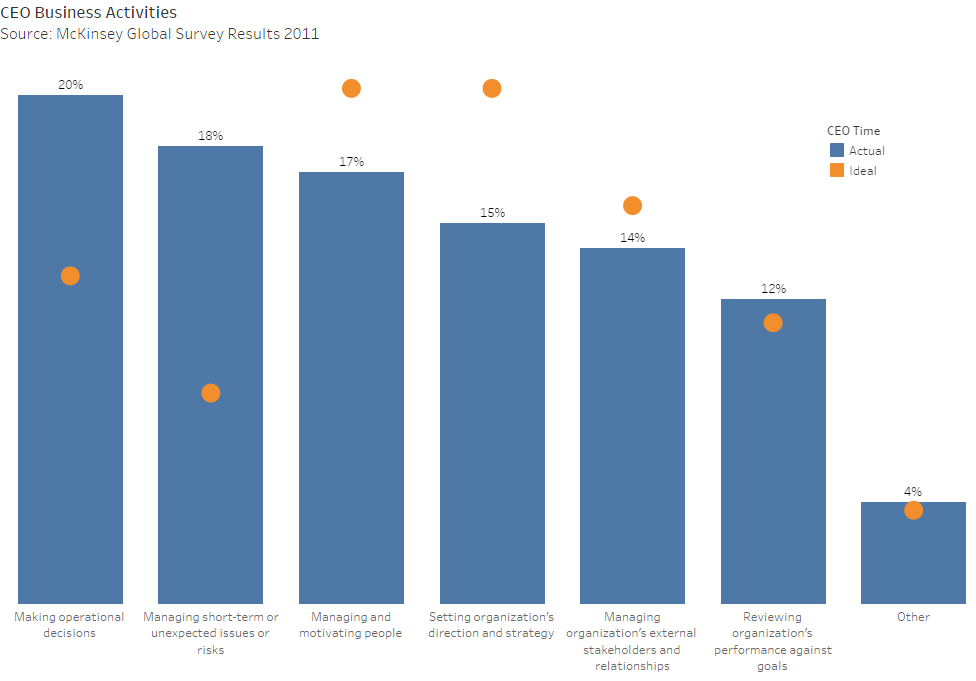One of the most gifted and creative consultants I’ve ever met is Mike Schrader, who is based in Columbia, Missouri.
Mike once said the first thing he asks a new client/owner is how they spend their time. He’s even had them track it for a week or two, allowing him to be a better coach to them.
When I broke into consulting, focusing on controllership activities, that made no sense to me at all. I always thought the role of the CEO was to fix problems. Slowly, I began to get it. That’s not their job. Right?
CEOs Are Focusing on Problems Instead of Opportunities
There are no surprises in a McKinsey Global survey tracking where CEOs spend their time. Many are stating they want more time to plan and motivate staff, as shown in the 2011 results below.

The results above are telling.
- CEOs are spending nearly double the time they should be on managing unexpected issues, indicating that they may not be effective at delegating or may not have the right team members in place.
- Likewise, they are also spending double the time planned in fighting fires when they could be focusing on culture, brand building, and business development.
- Not enough time is spent on direction and strategy, but at least we know why.
- There’s also not enough time spent coaching and mentoring the staff.
Peter Drucker, I now get you. You told us in The Effective Executive and other books that CEOs should focus on opportunities, not problems. This research echoes the points you made in the early 1960s. Lesson learned.
Several Suggestions for the CEO Bogged Down With Problems
In short, CEOs are spending too much time fighting fires and making operational decisions that could be delegated to trusted and competent staff.
Here are three ideas for CEOs to get on track and spend time where it’s needed most.
1. Start with Baby Steps
Start small. When I develop a relationship with a new CEO, I encourage them to schedule a day on the calendar when they can leave the office to plan what the business will look like in three years and then five years from now. Michael Ovitz did this periodically. So did the founder of Trader Joe’s. And many other phenomenal business founders.
At the risk of stating the obvious, the CEO works backward or reverse-engineers the new and bigger/better future. Consider asking the Dan Sullivan R-Factor Question®, which goes something like this:
If you and I were meeting 3 years from now, looking back, what would it take for you to feel happy about your progress?
I’ve asked that question hundreds of times. When I ask new clients Dan’s question, the conversation lasts an hour or more. Such a simple question, yet one that prompts deep introspection for a business owner who is not accustomed to thinking beyond the present.
2. Start Creating and Developing a Management Team
This part is tricky. Many CEOs I work with are strong business developers. Accordingly, I would like that to be their first hire as they step back and let others build the business.
Forget the COO title, but find someone who can handle the back office operations. If they have a LEAN mindset without being overly legalistic, that’s a plus. In many small businesses, the operations manager is one of the most important hires a CEO will ever make.
Now, we need an expert in administration, which typically involves two roles: a business manager and a financial manager.
These handful of people will hopefully eliminate 10-20 hours of grinding-type work that could be used for newer and better opportunities.
About half of my CEOs are avid readers, but for those who are, the best book on this topic is by my friend, Ed Hess, titled Smart Growth.
G3CFO Coaching Tip
If you know exactly what needs to be done, but you don’t want to do the work or have the energy to do it, you know you need a management team to address this void. Recognizing and acting on this void is the genesis of fleshing out your first management or leadership team.
3. Revisit Step Number One
While the second step might take a year or more to complete, once that group is in place, it’s now time to share your priorities and objectives with the people you’ve chosen to help you mind and grow the business with you.
But there is a catch. You can only be working on one major initiative at a time, maybe two. I would love to see your one-year plan for what you would like to accomplish. Remember, it’s a we-thing, and no longer an I-thing.
And this is where I get to plug my friends at the Strategic Coach. In this final step, they excel at cleverly and provocatively elevating the goals you want to accomplish.
Is It Time for a CEO Reboot?
Most small business CEOs need a reboot because they have hit the wall. More time is spent on problems instead of opportunities. Yesterday’s issues hinder the ability to land a new customer segment that could be transformational for the business.
There is no one-size-fits-all recipe for a CEO reboot. I always start with the three parts of the business and financial mind. I continue with a simple D.O.S. Conversation, which helps CEOs get out of a deep valley of despair and frustration.
The best way to determine if you need a CEO reboot is to revisit the McKinsey study and examine the numbers yourself. Or, perhaps track the number of restful sleeps you get each evening for a week.







